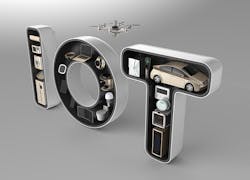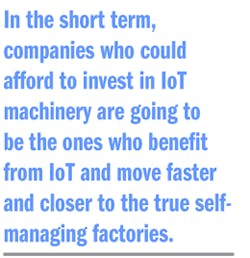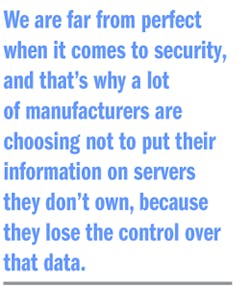Interview: Paving the Way to an IoT World
This file type includes high resolution graphics and schematics when applicable.
To get an idea of how IoT is growing within the U.S. and around the world, Machine Design talked with Marissa K. Tucker, product marketing manager for Controls and HMI at Parker Hannifin’s Electromechanical and Drives Division.
What is your definition of IoT?
In essence, the Internet of Things, or IoT, is just a network of physical devices, whether they are embedded with electronics or software or any sort of sensors that collect data and simply share it with other devices. Those really are the fundamentals of IoT. So you can easily make the argument that Parker—and, in fact, a lot of companies—have been doing that for decades.
The new thing and the excitement about IoT, and why it’s kind of coming to the forefront now, is that people are starting to take the concept from individual machines and really starting to share data between machines—which, again, is technology that’s been around and been used for decades. But even more exciting is that companies are starting to realize they can now group entire factories together.
How did the IoT get started?
It started about 20 years ago when engineers discovered they could control systems using Ethernet rather than through command signal, and bus-based networks started to overcome the traditional controlled networks. So all of a sudden, factories had to collect a lot more data from all of the sub-devices within a single machine so that managers could make better decisions based upon that. In addition, companies learned they could share information with other systems. And there are still a lot of systems out there that aren’t even doing any of this
If companies can really get their machines inside their factories communicating with each other, then they can get them to communicating directly with their enterprise-resource-planning (ERP) manufacturing execution systems (MES), and then to whatever global network they have as an enterprise. All of a sudden, we’re getting closer and closer to a fully automated factory that not only takes orders, compares what’s needed to what materials are in stock, and order additional parts as needed.
The automated factory can also schedule automatically and retool as necessary, using optimized algorithms. And all of this can be done without human intervention.
Of course, if any maintenance is needed—if there is any human maintenance required—the machine can simply contact the human, in theory, before even an error or maintenance issue arises. So, we’re inching ever closer to the self-managed factory. And that's always been the goal and promise of manufacturing, since Ford back in the day with efficiency. But there are still a thousand steps to get there.
Describe the differences between IoT, the Industrial Internet of Things (IIoT), and Industry 4.0.
The terms are used interchangeably in this industry, but slight differences exist between them. IoT usually includes consumer-based products and devices. IIoT, the Industrial Internet of Things, concerns manufacturing companies. And Industry 4.0, which some people use interchangeably with IIoT, is a German-defined knowledge strategy. It’s defined by the German government, which promotes and subsidizes IIoT, or just the general computerization of automation. And it’s called Industry 4.0 because they really see that the interconnectedness of the factory as basically the fourth Industrial Revolution.
Who will benefit—and will anyone lose out—because of IoT?
There will be some losers in the short term. But in the long term, everyone wins. The entities poised to win early are the large manufacturers with the capital to invest in the new technologies. And, in fact, they have been investing in this for a very, very long time. These larger companies already have had manufacturing systems that communicate with each other and with databases for a long time. They also know that the cost of building and implementing these networks can be ridiculously high.
What contributes to the costs?
For instance, every factory line is made up of five or six individual machines, and each packaging line is made up of five or six individual machines, and they can all be from different manufacturers. So, to get all of those machines talking with each other, you have to invest a considerable amount of money to get an integrator. The companies then have to standardize communications and data formats between machines, and that takes another huge upfront investment.
Companies also have to be careful. For example, some manufacturers tried standardizing their packaging lines by having all of the machines use the same controller. Many soon realized that standardizing on one controller gives the controller manufacturer a lot of power to increase prices and the cost of support, especially when a company is in a downtime situation.
Is there a way around some of these costs?
Some of these large manufacturers have learned from their mistakes and they’ve created new standards. A good example is PackML (Packaging Machine Language). Armed with that standard, a company can go to any machine builder and tell them to use whatever components they want, as long as the finished machine gives the company access to a specific type of data on all of its machines. In that way, the company can become more interconnected, and it’s a lot less expensive to integrate and to communicate.
In the short term, companies who could afford to invest in IoT machinery are going to be the ones who benefit from IoT and move faster and closer to the true self-managing factories. But small and medium manufacturers will also benefit from standardization and advances in technology.
The trick for these small- and medium-sized manufacturers is that a lot of them still don't even have the base foundation. There are still a lot of machines on factory floors because managers just wanted the lowest prices. Many of these brand-new machines cannot communicate in even the simplest terms with other machines; they’re just discrete logic-handling PLCs. These small- and medium-sized manufacturers have to be using intelligent devices. That’s really the foundational layer.
Are there any countries that seem much further advanced toward a more complete realization of IoT than others?
Some facets of Germany are a little ahead of where the U.S. is, but that’s because the government subsidizes a lot of medium-sized manufacturers to jump ahead. We don’t have the same system within the U.S., but we’re pretty much at the same level right now.
What’s the biggest stumbling block on the road to IoT?
Across the board, the biggest stumbling block is what’s in your factory right now. In most factories, there is going a combination of new and old machines. Some might have been built there in the 1980s, but they are still going strong. Updating them for IoT or replacing them, however, will be expensive. Some firms will have new machines they just purchased or relatively new machines that they retrofitted recently. So there’s going to be a huge variation in what companies have in their factories.
Another stumbling block is that some people define IoT as it being built around a network or cloud of external servers that will not be owned by individual manufacturers, but managed by someone else. If that is the case, it will be a long wait until IoT is fully in gear, because the manufacturers I talked to are not comfortable with storing and using data from the cloud or external servers. If you let IoT be based around a network owned and inside a company, you can still carry out many of the same tasks possible with external servers and everything hooked into the internet.
So where should companies start on the road to IoT?
The most important task for factory managers to do right now is to survey the machines in their factories, because that’s limitation. For example, if you have machines with discrete logic that cannot communicate with anything else in the factory, step one is figuring out how you’re going to get those machines to talk with others without completely replacing it—an incredibly expensive proposition.
Fortunately, there are already intermediate products out there to help customers connect the machines that are not interconnected. For example there are HMIs that have web-publishing capabilities that will let machines communicate using a wide variety of different drivers.
Companies should not be upgrading for the sake of upgrading, and I fear that’s what a lot of companies are doing right now. Instead, they should upgrade with a purpose, and the purpose is to get just the right data to all of the places that need it. So first they need to answer the question: What process, either an enterprise or a manufacturing process, could be improved by the collection and use of more data? That’s where you first start: Do things that make sense for your company.
We are far from perfect when it comes to security, and that’s why a lot of manufacturers are choosing not to put their information on servers they don’t own, because they lose the control over that data. And with the IoT, people are talking about putting much, if not all, of the company’s intellectual property in the web.
To get all of the talked-about IoT benefits, manufacturers need to convince customers to put their devices on my cloud and let me use their data. That’s not going to happen significantly within the next five to 10 years, because most manufacturers I talk to won’t put their information on the cloud in the first place. So although manufacturers want all that sharing to happen, I’m not convinced that’s what users want to happen. I’m not convinced they’re sold on the benefits yet, and I think the reason is because we don’t know what that data is, what it might lead to, and who exactly will have access to it.
Are standards necessary for IoT to grow faster?
There are two ways to go about standardizing an industry or technology: The government can mandate it, or you can see what happens naturally. It would be a lot quicker if someone with a gavel came around who said, “Okay, everyone will use this standard,” but we’re making good progress letting the free market do what it does best.
If we, as manufacturers, simply listen to the needs of what our OEM machine builders need and what their customers’ needs are, we’ll develop IoT very, very quickly. But we have to be listening and open to that kind of the change when the market is demanding standards from us, and telling us what those standards should be.
What can OEMs do to accelerate IoT capabilities in smaller companies?
A lot of small manufacturers are dragging their feet on even just getting the basic foundations for IoT, because they don't see any benefits. That’s why it’s important that OEMs provide the low-hanging-fruit capabilities such as predictive maintenance. They can set it up so that companies can get performance information in the offices instead of having to go down to the factory or call distant plants. That’s an important first step for a lot of these small- and medium-sized factories, and it gives them a pathway to IoT, but with benefits today.
This file type includes high resolution graphics and schematics when applicable.





